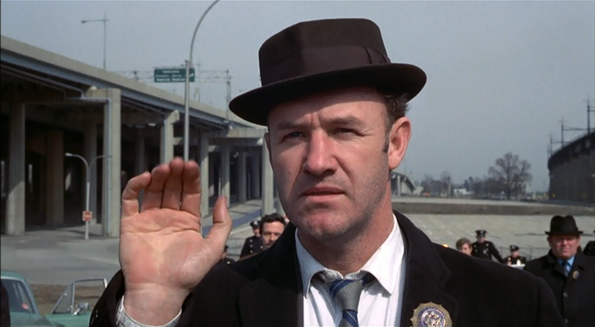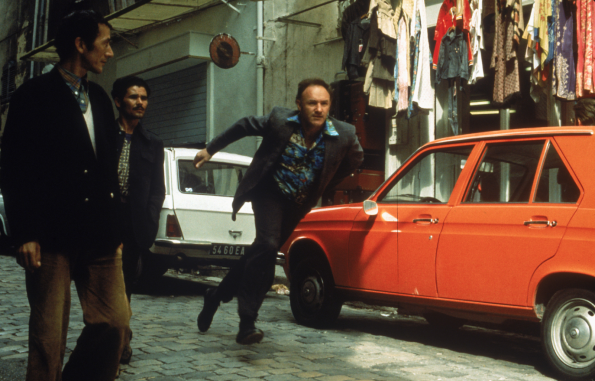
So you’re probably wondering why I’m reviewing a film, the French Connection, that came out long before I was born, in 1971, to be exact, and why I’m doing it now.
Basically, I have started immersing myself into classic (famous & otherwise) films that influenced the great movies and TV series I love in today’s culture. When show runners, directors, actors and producers are interviewed about their latest projects, they always reference films as inspiration that I have never seen before.
Today we change that by reviewing a film that has inspired many great crime, detective and espionage films for decades.
The French Connection is a crime drama based on the nonfiction book baring the same title.
The film was shot in the great city of New York during the winter months, while other scenes are in Marseille, France.
The scenes filmed in Marseille really drive home director William Friedkin’s vision of the hard contrast between the beautiful port city set resting on the edge of the Mediterranean Ocean, versus the scenes in New York that depict a dark, gritty and dangerous place.
The movie stars a young Gene Hackman as lead detective Jimmy “Popeye” Doyle. Doyle’s character is a hard-nosed detective who at times abuses his prowess as a lawman to get the answers he needs.
Doyle dresses in nickel suits, straps his snub-nosed .38 special to his ankle and wears a small flat fedora atop his giant head, giving the illusion that his ears are glued on to side of his skull.
Doyle’s partner is Detective Buddy ‘Cloudy’ Russo played by one of my favorite actors, Roy Scheider, who used to be one hell of an amateur boxer.
Roy is Doyle’s right-hand man, at times working in perfect tandem with little communication except for small nods and subtle glances.
If Doyle is the wild card of the two, Cloudy Russo is the ace in the hole. Both tend to work on the edge of right and wrong, both understand the streets in a way that their commanding officers would never know.
The plot revolves around a successful French drug dealer named Alain Charnier (Fernando Rey). His plan is to smuggle in $32 million of nearly pure heroin into the US under the guise of popular and beloved television personality Henri Devereaux (Fredireic de Pasquale).
Charnier’s parter and henchman Pierre Nicoli (Marcel Bozzuffi) warns his partner about using the celebrity in their scheme, foreshadowing some issues that develop over the period of a few weeks.
The most dynamic scenes of the movie occur when Hackman lets loose with his interpretation of Popeye Doyle.
Hackman, who in 1971 was handsome in a rugged kind of way, finds a way to make himself look tired and deprived, all while keeping that flashy smile and frat-boy snicker that made his version of Lex Luthor so charming, yet sinister.
If you’re a Hackman fan, you’ll love when Doyle and Cloudy go to a nightclub after a daylong shift undercover. The gritty realism is unmistakable and encapsulates the 1970s in vivid detail. However, there are some issues with the scene that in today’s filmmaking landscape could have been fixed easily.
 The club is swinging with a Diana Ross and the Supremes like group singing while gangsters sit in booth’s snorting coke and feeling up prostitutes.
The club is swinging with a Diana Ross and the Supremes like group singing while gangsters sit in booth’s snorting coke and feeling up prostitutes.
The sound and mixing during this scene was a bit difficult to watch at first mostly because it’s hard to hear Doyle and Cloudy speak due to the music in the club.
Granted, eventually the music does cut out midway through the song during to allow the dialog to breathe, even if it’s a little too late.
Here’s where today’s sensibilities kick in — sound mixing and editing has become something we take for granted in our time. However, even with their limited technology then, the film pulls off a great recovery while the band sings their last note and leaves the stage, letting the dialog to flow.
Comparing this film to today’s technology and you come to appreciate how it truly enhances the viewers’ experience.
Although, one thing our technology today cannot enhance is one of the movie’s most famous scenes.
The scene starts with French henchman Nicoli aiming to take out Popeye with a sniper shot. He fires the round, but instead of hitting Popeye, it strikes a poor mother taking her child out on a stroll. She takes the rifle bullet to the back where it should have been buried into Popeye’s chest. This starts a chain of events that leads to a subway/stolen vehicle chase scene through the streets of New York. The train up above carrying the assassin runs through designated stops as a mad-eyed Popeye Doyle, below the train, is in pursuit after he commandeers a brown Pontiac sedan.
The camera mounted on the front bumper is used seriously, not the clownish way it’s parodied in the opening scenes of Naked Gun as it drives through car washes and ladies locker rooms.
The view from below the windshield versus Naked Gun’s top mounted siren gives a terrifying view of how close these stuntmen came to hitting vehicles, sets and extras. The scene’s realism makes for some tense moments because Popeye is a terrible driver. He rams other vehicles as he blows through red lights and nearly takes out pedestrians left and right.
It’s an amazing scene that melds Hackman’s intense facial expressions into rear-end clinching action because there are times you feel like he really is nearly killing innocent, frozen New Yorkers while they make their commute home.
Moving on, though, as the film winds down, the ending is a bit of a shocker.
Popeye and crew have the bad guys, including the French drug Kingpin Alain Charnier, trapped in a maze of decrepit New York warehouses where most of the bad guys either surrender or get shot, except for Charnier.
Somehow he slips out of the grasp of the New York’s finest and escapes into the unknown. The scene ends with Popeye, infuriated and running on pure hate, taking off after Charnier in the warehouse, firing one last shot off screen.
And that’s it. Loose ends a plenty. Did he catch him? Did Charnier get away? Your guess is good as any, or so it might seem.
I for one, hate vague endings but this one redeems itself because they do the pre-credits roll of “So and so received a 20 year sentence in maximum security prison” so there is some closure.
It’s still kind of a piss-poor ending, though, when the bad guys get away and are suspected to be back in France living in his medieval castle on the sea.
Our hero detective, meanwhile, sleeps on a cot in his studio apartment in the projects.
In the end, The French Connection does hold up to modern sensibilities.
Hackman plays a believable detective on the verge of being passed up by the times he is living in. The world of freely being able to beat black men and call them the “N” word to get information was nearly done and over with in the late 70’s early 80’s.
The grey areas were starting to be encroached upon by the black and white. Hackman’s Doyle was a dying breed of cop in a city changing too fast for his motor to keep up with and unfortunately, Doyle was fully aware of it.
When Nathan isn’t sitting slack jaw at his work desk or watching classic movies, he’s producing his own podcast called True Montana. Check out new episodes at www.TrueMontana.com

